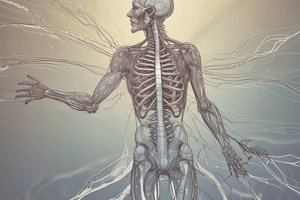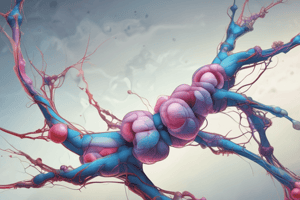Podcast
Questions and Answers
Which neurotransmitter is primarily involved in regulating sleep, appetite, and mood?
Which neurotransmitter is primarily involved in regulating sleep, appetite, and mood?
- Acetylcholine
- Serotonin (correct)
- Norepinephrine
- Dopamine
The somatic nervous system is a component of the central nervous system.
The somatic nervous system is a component of the central nervous system.
False (B)
What is the primary function of the autonomic nervous system?
What is the primary function of the autonomic nervous system?
Regulates involuntary bodily functions
The space between two neurons where neurotransmitters are released is called the ______.
The space between two neurons where neurotransmitters are released is called the ______.
Which neurotransmitter is associated with voluntary movement, attention, and feelings of pleasure and reward?
Which neurotransmitter is associated with voluntary movement, attention, and feelings of pleasure and reward?
Neurogenesis, the formation of new neurons, occurs extensively throughout adulthood in all brain regions.
Neurogenesis, the formation of new neurons, occurs extensively throughout adulthood in all brain regions.
Which neurotransmitter is associated with muscle action, arousal, and memory?
Which neurotransmitter is associated with muscle action, arousal, and memory?
Which of the following hormones is primarily involved in regulating daily biological rhythms and promoting sleep?
Which of the following hormones is primarily involved in regulating daily biological rhythms and promoting sleep?
Neuromodulators are long-distance messengers released directly into the bloodstream.
Neuromodulators are long-distance messengers released directly into the bloodstream.
Which neurotransmitter affects neurons involved in learning, memory, dreaming, waking from sleep, and emotion, as well as influencing heart rate and intestinal activity during stress?
Which neurotransmitter affects neurons involved in learning, memory, dreaming, waking from sleep, and emotion, as well as influencing heart rate and intestinal activity during stress?
The outer part of the adrenal gland produces _____, which increases blood sugar levels and boosts energy.
The outer part of the adrenal gland produces _____, which increases blood sugar levels and boosts energy.
Which hormone stimulates uterine contractions during childbirth and facilitates milk ejection during nursing?
Which hormone stimulates uterine contractions during childbirth and facilitates milk ejection during nursing?
Estrogens are primarily classified as 'musicalizing hormones' due to their effects on voice deepening and hair growth.
Estrogens are primarily classified as 'musicalizing hormones' due to their effects on voice deepening and hair growth.
What is the role of the serotonin transporter?
What is the role of the serotonin transporter?
Match the following hormones with their primary function:
Match the following hormones with their primary function:
Flashcards
Neurotransmitters
Neurotransmitters
Chemicals that transmit signals across a synapse.
Norepinephrine
Norepinephrine
Influences heart rate, intestinal activity during stress and affects learning, memory, dreaming, waking, and emotion.
Hormones
Hormones
Chemical messengers released into the bloodstream to affect distant organs.
Melatonin
Melatonin
Signup and view all the flashcards
Oxytocin
Oxytocin
Signup and view all the flashcards
Adrenal Hormones
Adrenal Hormones
Signup and view all the flashcards
Androgens
Androgens
Signup and view all the flashcards
Estrogens
Estrogens
Signup and view all the flashcards
Neurons
Neurons
Signup and view all the flashcards
Dendrites
Dendrites
Signup and view all the flashcards
Axon
Axon
Signup and view all the flashcards
Synapse
Synapse
Signup and view all the flashcards
Nervous System's Functions
Nervous System's Functions
Signup and view all the flashcards
Central Nervous System
Central Nervous System
Signup and view all the flashcards
Peripheral Nervous System (PNS)
Peripheral Nervous System (PNS)
Signup and view all the flashcards
Endorphins
Endorphins
Signup and view all the flashcards
Pons
Pons
Signup and view all the flashcards
Medulla
Medulla
Signup and view all the flashcards
Cerebellum
Cerebellum
Signup and view all the flashcards
Thalamus
Thalamus
Signup and view all the flashcards
Hypothalamus
Hypothalamus
Signup and view all the flashcards
Pituitary gland
Pituitary gland
Signup and view all the flashcards
Amygdala
Amygdala
Signup and view all the flashcards
Hippocampus
Hippocampus
Signup and view all the flashcards
Cerebrum
Cerebrum
Signup and view all the flashcards
Right Cerebral Hemisphere
Right Cerebral Hemisphere
Signup and view all the flashcards
Left Cerebral Hemisphere
Left Cerebral Hemisphere
Signup and view all the flashcards
Cerebral Cortex
Cerebral Cortex
Signup and view all the flashcards
Occipital Lobes
Occipital Lobes
Signup and view all the flashcards
Parietal Lobes
Parietal Lobes
Signup and view all the flashcards
Study Notes
- The brain and nervous system allows people to know when they are hurt.
The Nervous System
- Key components include neurons, dendrites, and axons
- It also includes the parasympathetic nervous system, myelin sheath, neurogenesis, and synapses
- The nervous system does not discuss action potential
Function of the Nervous System
- The nervous system gathers and processes information.
- It produces responses to stimuli.
- The nervous system coordinates the workings of different cells.
- The nervous system has two parts:
- Central Nervous System
- Peripheral Nervous System (PNS)
Central Nervous System
- The central nervous system includes the brain, spinal cord, and nerves.
Peripheral Nervous System (PNS)
- The peripheral nervous system is divided into:
- Somatic (bodily) nervous system
- Autonomic nervous system
- Sympathetic nervous system
- Parasympathetic nervous system
Chemical Messengers within the Nervous System
- Chemical Messengers within the nervous system include neurotransmitters.
- Chemical Messengers are important to follow a particular path.
Neurotransmitters
- Serotonin affects neurons involved in sleep, appetite, sensory perception, temperature regulation, pain suppression, and mood.
- Dopamine affects neurons involved in voluntary movement, attention, learning, memory, emotion, pleasure and reward, and responses to novelty.
- Acetylcholine affects neurons involved in muscle action, arousal, vigilance, memory, and emotion.
- Norepinephrine affects neurons involved in increased heart rate and the slowing of intestinal activity during stress. It also affects neurons involved in learning, memory, dreaming, waking from sleep, and emotion.
Hormones
- Hormones are long-distance messengers released in the bloodstream
Specific Hormones
- Melatonin regulates daily biological rhythms and promotes sleep.
- Oxytocin stimulates uterine contractions during childbirth, facilitates the ejection of milk during nursing, and promotes attachment and trust in relationships.
- Adrenal hormones are involved in emotion and stress.
- The outer adrenal gland produces cortisol, which increases blood sugar levels and boosts energy.
- The inner part produces epinephrine/adrenaline and norepinephrine, which prepares the body for fight or flight.
- Sex hormones are androgens, estrogens and progesterone.
- Androgens musicalize hormones and influences deepened voices, facial/chest hair, and sexual arousal.
- Estrogens feminizes hormones during breast development and the onset of menstruation.
- Progesterone aids growth and maintenance of the uterine lining for a fertilized egg.
Neuromodulators
- Neuromodulators control the brain's volume.
- Serotonin transporters pick up leftover serotonin and transport it back to the sending neuron for recycling.
- Endorphins: reduces pain and promotes pleasure, playing a role in appetite, sexual activity, blood pressure, mood, learning, and memory.
Happy Chemicals
- Happy chemicals promote happiness and pleasure while reducing depression and anxiety.
- These chemicals include Serotonin, dopamine, endorphins, and oxytocin.
- Endorphins are neuromodulators that help one cope with pain and stress, and dopamine is a mood-boosting neurotransmitter released after reaching a goal.
Mapping the Brain
- Ways to map the brain include electroencephalograms, PET scans (positron-emission tomography), transcranial direct current stimulation, transcranial magnetic stimulation, and lesion methods
Key Brain Components
- Pons are key for sleeping, waking, and dreaming
- Medulla is involves in bodily functions not consciously willed
- Cerebellum supports sense of balance and coordinating of the muscles and remembering simple skills and acquired reflexes
- Thalamus directs sensory messages to higher areas, except the sense of smell. The thalamus us a sensory relay station
- Hypothalamus is responsible for monitoring the body's current state and issue instruction to help the body maintain a steady state for basic survival drives
- Pituitary gland sends out hormonal messages
- Amygdala evaluates sensory information, determining it's emotional important to contribute to to the initial approach or withdraw feeling/action
- Hippocampus supports storage of new information in memory.
- Cerebrum is in charge of sensory, motor, and cognitive processes
- Cerebral hemispheres:
- Right hemisphere controls the left side of the body
- Left hemisphere controls the right side of the body
Lateralization in the Two Hemispheres
- Logic is commonly associated with the left hemisphere of the brain.
- Creativity is commonly associated with the right hemisphere of the brain.
Cerebral cortex
- Higher mental functions
- Lobes of the cortex:
- Occipital lobes
- Parietal lobes
- Temporal lobes
- Frontal lobes
Functions of Key Parts of the Brain
- Brain stem: involved in basic life functions.
- Pons: functions in sleeping, waking, and dreaming.
- Medulla: facilitates automatic functions, such as breathing and heart rate.
- Reticular activating system (RAS): extends into the center of the brain, screening incoming information and arousing higher centers of consciousness.
- Cerebellum: supports balance, muscular coordination, and memory for simple skills and learned reflexes.
- Thalamus: relays impulses from higher centers to the spinal cord and incoming sensory information, but not olfactory sensations, to other brain centers.
- Hypothalamus: controls survival behaviors like hunger, thirst, emotion, and reproduction, as well as regulating body temperature and the autonomic nervous system.
- Pituitary gland: directs the hypothalamus and secretes hormones, affecting other glands.
- Amygdala: evaluates sensory information to determine its importance and mediates anxiety, depression, and the formation/retrieval of emotional memories.
- Hippocampus: compares new sensory information with existing knowledge to regulate the RAS, also forming new memories about facts and events.
- Cerebrum (including cerebral cortex): involved in higher forms of thinking.
- Occipital lobes: supports visual processing.
- Parietal lobes: processes pressure, pain, touch, and temperature.
- Temporal lobes: functions in memory, perception, emotion, hearing, and language comprehension. Frontal lobes: responsible for movement, short-term memory, planning, setting goals, creative thinking, initiative, social judgment, rational decision making, and speech production.
Plasticity
- Plasticity is the brains ability to change in response to new experiences. It is most pronounced during infancy and early childhood, with a resurgence in adolescence.
Debunking Popular Psycology: His or Her Brain?
- Do the brains of males and females differ on average, in structure or function?
- If what differs, does so in men and women's behavior?
Studying That Suits You
Use AI to generate personalized quizzes and flashcards to suit your learning preferences.




